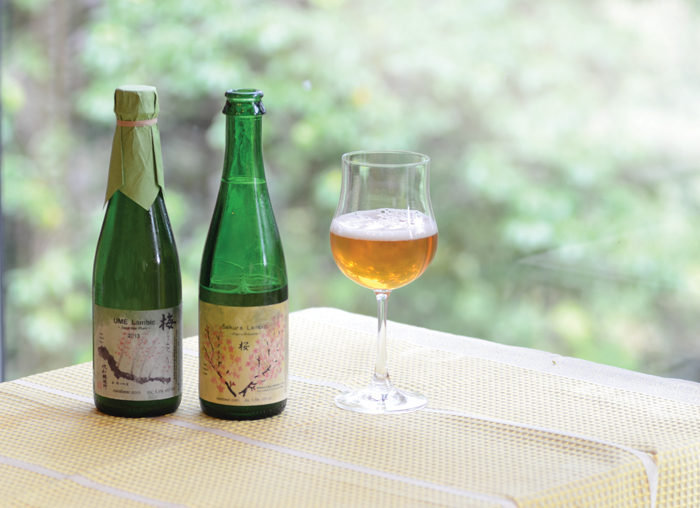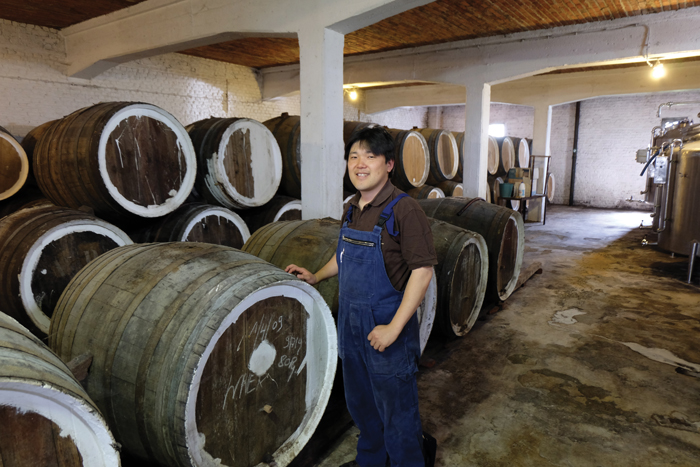If you are the kind of beer lover who, like me, regularly goes into bars and stores searching for new and strange beers to try, then it is likely that you have come across the curiously-named Owa beers of Belgium. The name is a neologism combining the characters 欧 signifying “Europe” and 和 signifying “Japan,” and the choice of the name is rather apt, as these are Belgian-style beers made in Belgium by Japanese brewer and businessman Leo Imai.
From the start, Owa’s sales have been primarily focused on Europe, particularly Belgium, so it has been difficult to find the beers in Japan. The flagship Owa Beer was sometimes encountered at specialty pubs and festivals, but only rarely. This is changing though, with all of Owa’s offerings trickling into the country in bottles, with hopefully more kegs coming soon as well.
I met Imai in Brussels in the fall of 2013, and again in Kyoto early this year, where we spoke about his brewing history, his beers, and his plans for the future.
After graduating from university, Yokohama-born Imai took a job with Kirin City, the restaurant chain, his goal being to get enough training to be able to manage his own pub or restaurant eventually. He never planned to become a brewer, he says smiling.
Imai was transferred to the Kirin City branch in Düsseldorf, Germany, in 1999, and has lived in Europe ever since. He worked in the Kirin City restaurant and also helped with the export of hops and malt to Japan. He felt too separated from the beer-making, however. New beers would come out, he recalls, and he would only find out about them from a website. When introducing these beers to his customers, he felt he wanted to have a deeper understanding of just how these beers were made. This led him to make a big change in career.
In 2001, Imai moved to Scotland to pursue an MS degree in brewing and distilling science at Heriot-Watt University. After completing his course, he took a job as assistant brewer at Prösslbräu, a small brewery outside of Regensburg, Germany. After a three-year stint there, Imai moved to Belgium in 2005.
Upon arriving in Belgium, Imai worked at the Brussels brewery of De la Senne, an upcoming brewer with unique ideas and characterful beers. At the time, though, they were still young and did not have enough production, so it was a less-than-steady job.
Imai then opened his own brewery, which he ran for a time, but soon found it too expensive and labor-intensive. He recalls the many difficulties: equipment needs, cleaning, sanitation, not to mention brewing. He was doing it alone, and it proved to be too much to handle, so he decided that contract brewing was a better option.
Imai thought at first that Belgian people would probably reject beer made by a Japanese, just as he imagined that Japanese people would be disinclined to drink sake made by a foreigner. He was surprised, though, when it did not seem to matter to the Belgians. “They just want to drink good beer,” he relates. “But also,” he adds, “they want to use local products from small producers.” The tendency to buy local is much stronger in Belgium than in Japan, he thinks. In Japan, most people do not think twice about going to izakaya, family restaurants, and convenient stores run by large chains. They are an ingrained part of life. In Belgium, they also have supermarkets and chain stores, but many people prefer to go to small, privately-owned restaurants and bars, and to buy their food at the market whenever possible. They want to see the people who produce their foods and drinks. Imai feels that this mentality has helped him succeed in Belgium.
It was a long time, however, before Imai could turn a profit selling beer. At one point, he had to decide: either the apartment or the warehouse—one had to go, because he could not afford both. So he lived in his warehouse for a year, sleeping on a bed made of beer boxes. He recalls how loud it was when the rain hit the metal roof, and how cold it was in winter, with no hot water. Those days have passed, however. Imai has built a solid beer business, though he is far from relaxing and coasting on his laurels. He manages the Kushi-tei restaurant in Brussels, which of course features Owa beers. He also does much of the cooking himself.
Imai is a surprisingly soft-spoken, modest individual. He sometimes seems too humble for a man who has become such a successful brewer and brewery-manager abroad, and, at least among the few who know, something of a hero to beer lovers at home. Besides that, Imai is totally proficient in English and German, and gets by in French and Dutch as well. He is the very image of an old-school Belgian brewer: uninterested in marketing and hype, wishing to make beers that people buy because they like to drink them. (He does invest in lovely washi labels for his lambics, though, which raise the price of the beers quite a bit!)
Owa Brewing currently produces six beers. The standards are Owa Beer (5.5%), a fruity and earthy Belgian Pale Ale, and Owa Kuro (8%), a strong Belgian dark ale with flavors of chocolate, raisins, and lots of umami. Every year, a limited amount of Owa Grand Cru (8%) is also released. This is the Kuro aged ten months in Bordeaux red wine barrels. Grand Cru is slightly more complex than the base beer, with notes of cherry, figs, more dried fruits, and wood.
What really gets me excited are Owa’s three fruit lambics. Following age-old Flemish tradition, Imai steeps fruit in young or old lambic from DeTroch (a traditional brewer that uses most of their lambic in sweetened fruit beers). He’s not making kriek or framboise, though. He uses iconic Japanese fruits instead, for a very unique twist.
Yuzu Lambic is made with yuzu peels shipped frozen from Wakayama. Imai then zests the peels himself. One batch of beer consumes 80 hours of zesting time! He steeps the zest in four-month old De Troch lambic for two months, to the tune of one yuzu per 375 ml bottle. The result is a beer with a huge yuzu nose, but little lingering sweetness (none of the Owa Lambics contain sugar or other added sweeteners). It is dry and crisp, with a funky lambic character.
Ume Lambic also uses frozen fruit shipped from Wakayama. Frozen ume actually works better for infusing in lambic, Imai says, as the cell walls are broken and the flavor is released more freely. He steeps the ume in 1-year-old De Troch Oude Lambic, to the rate of three to four fruit per 375ml bottle, for two months. The result is a very sour, funky drink with big ume flavor that is quite challenging to people unaccustomed to lambic flavors, but adored by those of us who are!
Owa’s latest fruity creation is Sakura Lambic. Similar to some other Sakura beers that have appeared in Japan over the last few years, this uses sakura leaves that have been pickled in salt, as done with that spring treat, sakuramochi. The leaves get infused in three-month-old De Troch lambic for three months, which results in a slightly sweet, salty beer with flavors of cherries and even rice mochi (or is it just my imagination linking the two?). This is the least tart of Owa’s lambics, and perhaps the most accessible to people unaccustomed to sour beers. It’s certainly the most unorthodox of the three.
Imai says he plans to introduce a Belgian witbier to his lineup next, as he thinks this style not only goes well with the Japanese cuisine he sells at Kushi-tei, but that it would also be popular back home.
Leo Imai has no plans to move back to Japan any time soon. He would consider it, he says, but it doesn’t seem likely financially. Start-up costs for a brewery are very high. The 60,000 liter minimum is a problem, too, as are taxes. In Japan, he thinks, there are not enough tax incentives for small breweries. In Belgium, there is a four-tier system based upon brewery size so that for a 330 ml bottle of Owa beer, the tax is just €0.05. In Japan, it would be about ¥65. So for now, we will have to rely on imports if we want to drink Owa Beer. At this time, 20% of his production is exported to Japan, with that figure likely to rise in the near future. Much of it is sold at Isetan Department Stores in the Kanto area, though the author has also seen it at specialty beer stores in Tokyo Station as well as in Nagoya. I won’t be satisfied until I can drink Imai’s fabulous fruit lambic straight from the cask here in Japan, though I might just have to wait a while for that.
Mark Meli
This article was published in Japan Beer Times # () and is among the limited content available online. Order your copy through our online shop or download the digital version from the iTunes store to access the full contents of this issue.





